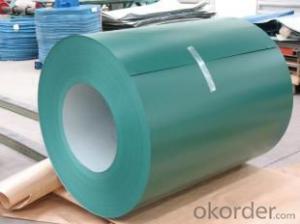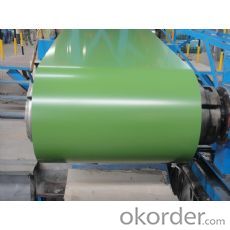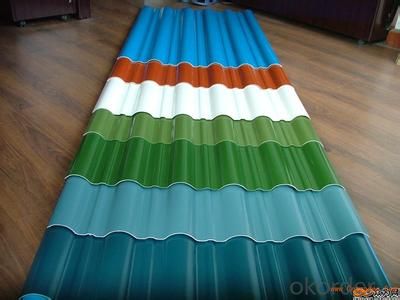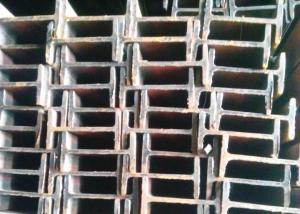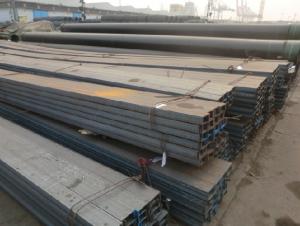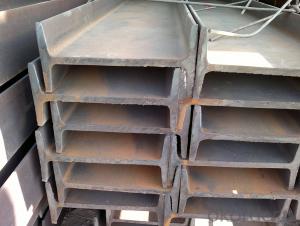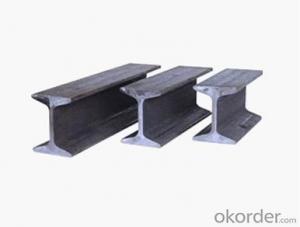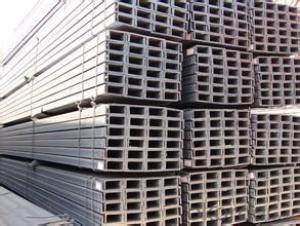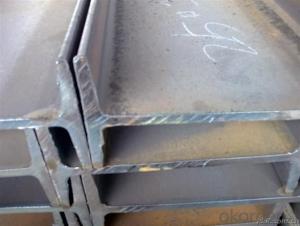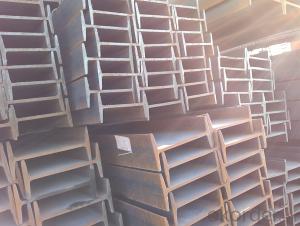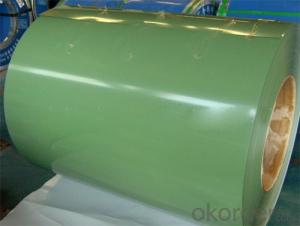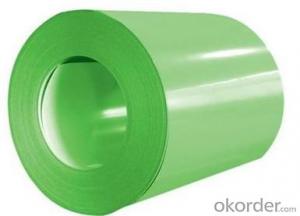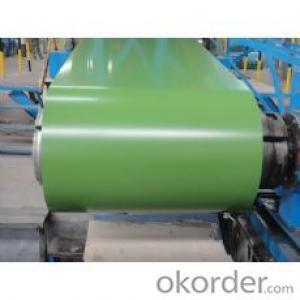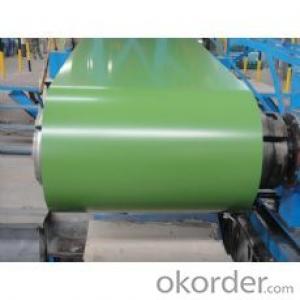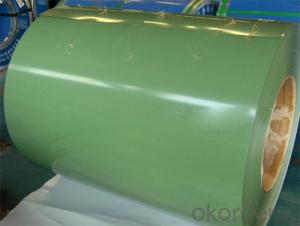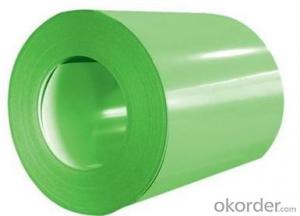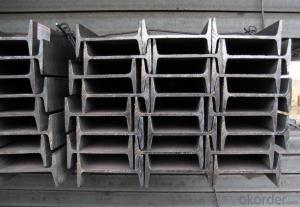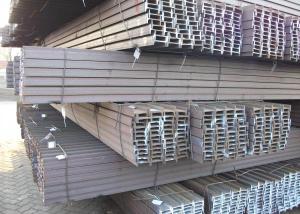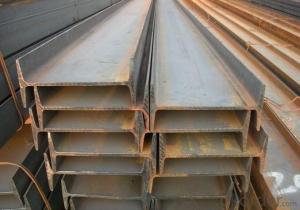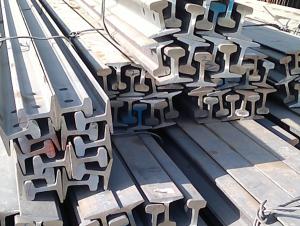Pre Painted Galvanized/Aluzinc Steel Coils of Best Quality Green Color
- Loading Port:
- Shanghai
- Payment Terms:
- TT OR LC
- Min Order Qty:
- 50 m.t.
- Supply Capability:
- 2000 m.t./month
OKorder Service Pledge
OKorder Financial Service
You Might Also Like
1. Pre-Painted Galvanized/Aluzinc Steel Coil Description:
With GI as base material, after pretreatment (degrease and chemical treatment ) and liquid dope with several layers of color, then after firing and cooling, finally the plate steel is called pre-painted galvanized (aluzinc) steel. Pre-painted galvanized steel is good capable of decoration, molding, corrosion resistance. It generally displays superior workability, durability and weather resistance.
2.Main Features of the Pre-Painted Galvanized/Aluzinc Steel Coil:
• Excellent process capability
• Smooth and flat surface
• Workability, durability
• Excellent heat resistance performance
• High strength
• Good formability
• Good visual effect
3.Pre-Painted Galvanized/Aluzinc Steel Coil Images
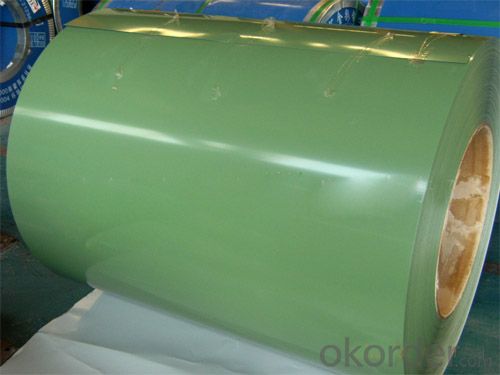
4.Pre-Painted Galvanized/Aluzinc Steel Coil Specification
Standard: AISI, ASTM, BS, DIN, GB, JIS
Grade: DX51D, DX52D
Thickness: 0.17-2.0mm
Brand Name: KMRLON
Model Number: coil
Type: Steel Coil
Technique: Cold Rolled
Surface Treatment: Coated
Application: Boiler Plate
Special Use: High-strength Steel Plate
Width: 20-1250mm
Length: customized
commoidty: pre-painted galvanized steel coil
Thickness: 0.13-4.0mm
width: 20-1250mm
zinc coating: 40-180g/m2
printing thickness: top side: 20+/-5 microns, back side: 5-7 microns
color: all RAL color
surface treatment: color coated
coil weight: 4-7 tons
coil ID: 508/610mm
packaging: standard seaworthy packing
5.FAQ of Pre-Painted Galvanized/Aluzinc Steel Coil
1. What’s the application of this product?
Roof, roof structure, surface sheet of balcony, frame of window, etc.
2. What’s the brand of the paint?
We use the best brand of all of the word—AKZO.
3. How about your company?
A world class manufacturer & supplier of castings forging in carbon steel and alloy steel,is one of the large-scale professional investment casting production bases in China,consisting of both casting foundry forging and machining factory. Annually more than 8000 tons Precision casting and forging parts are exported to markets in Europe,America and Japan. OEM casting and forging service available according to customer’s requirements.
4. How to guarantee the quality of the products?
We have established the international advanced quality management system,every link from raw material to final product we have strict quality test;We resolutely put an end to unqualified products flowing into the market. At the same time, we will provide necessary follow-up service assurance.
5. How long can we receive the product after purchase?
Usually within thirty working days after receiving buyer’s advance payment or LC. We will arrange the factory manufacturing as soon as possible. The cargo readiness usually takes 15-25 days, but the shipment will depend on the vessel situation.
- Q: Do Steel I-Beams require special handling during installation?
- Special handling is required for the installation of Steel I-Beams due to their heavy weight and large size. To ensure safe and efficient installation, several key considerations must be taken into account. Firstly, specialized lifting equipment such as cranes or forklifts with sufficient lifting capacity should be utilized to handle and position the I-Beams. This will prevent any damage during the lifting process and reduce the likelihood of accidents. Adequate manpower is also necessary to assist in the handling and installation of Steel I-Beams. Trained personnel should be assigned to guide and direct the lifting equipment, ensuring proper alignment and positioning during installation. Protective measures should be implemented to prevent scratches, dents, or other damage to the I-Beams during transportation and installation. This can be achieved by using protective coverings or padding to prevent contact with other surfaces or objects. Once the I-Beams are in position, it is crucial to secure them properly to prevent any potential movement or displacement. This may involve using appropriate connectors, bolts, or welding techniques as specified by the structural engineer or manufacturer. Compliance with safety regulations is essential throughout the handling and installation process. Workers should be equipped with the necessary personal protective equipment (PPE), and all relevant safety protocols should be followed. By adhering to these special handling procedures, Steel I-Beams can be safely and effectively installed, minimizing the risk of accidents, damage, or structural issues.
- Q: How do steel I-beams perform in terms of vibration control?
- Steel I-beams are widely recognized for their exceptional strength and load-bearing capabilities. However, when it comes to vibration control, their performance may vary depending on several factors. Firstly, steel I-beams have a natural frequency at which they tend to vibrate. This natural frequency is determined by their dimensions, material properties, and overall structural configuration. If the excitation frequency of the vibration matches the natural frequency of the beam, resonance can occur, leading to increased vibrations and potentially compromising the structural integrity. To mitigate vibrations in steel I-beams, several strategies can be employed. One common approach is to increase the stiffness of the beam by adding additional steel plates or braces. This increases the natural frequency of the beam, making it less susceptible to resonance with external vibrations. Additionally, damping systems can be incorporated into the design of steel I-beams to dissipate energy and reduce vibrations. These systems typically consist of damping materials, such as viscoelastic polymers or rubber pads, that absorb and dissipate vibrational energy. It is worth noting that the performance of steel I-beams in terms of vibration control can also be influenced by the surrounding structural elements and the overall design of the building or structure. For example, the presence of other damping elements, such as tuned mass dampers or base isolators, can further enhance the vibration control capabilities of steel I-beams. In summary, steel I-beams have inherent natural frequencies that can affect their performance in terms of vibration control. By increasing stiffness and incorporating damping systems, the vibrations can be mitigated and the overall structural integrity can be maintained. However, it is crucial to consider the specific design requirements and surrounding structural elements to optimize the vibration control performance of steel I-beams.
- Q: Are steel I-beams suitable for modular construction?
- Yes, steel I-beams are highly suitable for modular construction. Their strength, durability, and versatility make them an ideal choice for supporting the weight of modular units, providing stability, and ensuring the structural integrity of the overall construction. Additionally, steel I-beams can be easily transported, assembled, and disassembled, making them compatible with the modular construction process.
- Q: How do steel I-beams perform in high-snow load areas?
- Steel I-beams perform well in high-snow load areas due to their strength and durability. The structural integrity of steel makes it capable of withstanding heavy snow loads without significant deformation or failure. Additionally, the inherent rigidity of steel I-beams helps distribute the weight of the snow evenly, reducing the risk of structural damage.
- Q: Can steel I-beams be customized to specific project requirements?
- Yes, steel I-beams can be customized to specific project requirements. Steel I-beams are highly versatile and can be fabricated to meet unique specifications. The customization process involves adjusting the dimensions, lengths, and shapes of the beams to suit the project's specific load-bearing requirements. This can include altering the height, width, and thickness of the flanges and web of the beam. Additionally, steel I-beams can be customized with various surface treatments such as galvanization or painting to enhance their durability and corrosion resistance. Overall, the ability to customize steel I-beams allows for optimal structural design and ensures that they meet the exact needs of the project at hand.
- Q: Shape steel bending machine to make 18 I-beam, how to calculate the radian?
- First, determine the construction drawings of arch arch, hole radius, know high body width, the radius can be determined.
- Q: What are the common maintenance practices for steel I-beams?
- Common maintenance practices for steel I-beams include regular inspection for signs of corrosion or damage, cleaning to remove dirt and debris, applying protective coatings or paints to prevent rusting, and addressing any structural issues promptly through repairs or reinforcement. Additionally, ensuring proper drainage and preventing water accumulation can help prevent corrosion and extend the lifespan of steel I-beams.
- Q: Are there any limitations on the length of steel I-beams?
- The length of steel I-beams is subject to limitations. These limitations stem from the manufacturing process, transportation restrictions, and the structural needs of the specific application. When it comes to manufacturing, the length of steel I-beams is primarily restricted by the size of the equipment employed in their production. Steel mills utilize machinery designed for shaping steel into different forms, including I-beams. These machines have their own maximum length limitations. Transportation constraints also contribute to the limitation of steel I-beam lengths. Longer beams may pose difficulties during transportation due to weight restrictions, road or bridge limitations, or logistical obstacles. Compliance with local regulations and transportation capabilities necessitates consideration of the beams' size and weight. Additionally, the structural requirements of the application influence the length of steel I-beams. Longer beams may require additional support, such as intermediate columns or bracing, to ensure structural stability. The beam's strength and rigidity must be evaluated in relation to the span it is intended to cover. In conclusion, although there are no universal fixed limits on the length of steel I-beams, their dimensions are generally determined by the capabilities of the manufacturing process, transportation restrictions, and the structural demands of the particular application.
- Q: Can steel I-beams be used in the construction of convention centers?
- Certainly, convention centers can employ steel I-beams in their construction. The utilization of steel I-beams is widespread in the field of construction owing to their remarkable strength, durability, and adaptability. These beams offer exceptional support and load-bearing capacities, rendering them superb for erecting extensive edifices such as convention centers. They can be employed for framing, supports, and columns, thereby contributing to the establishment of a resilient and secure structure. Moreover, steel constitutes a sustainable and eco-friendly material, thereby increasing its popularity in contemporary construction endeavors.
- Q: What are the common connections used with steel I-beams?
- Construction and engineering projects often utilize various connections for steel I-beams. These connections aim to enhance stability, strength, and rigidity of the overall structure. A frequently employed connection is welding. This method involves welding the ends of the I-beams together, resulting in a solid and continuous joint. Welded connections are favored for their robustness and durability, as they create a seamless bond between the beams. However, skilled welding professionals are necessary for this technique, and it can be time-consuming. Another popular connection method is using bolts. This approach involves securing the I-beams together using bolts and nuts. Bolted connections are well-liked due to their ease of installation and versatility. They can be easily adjusted or dismantled if required, making them suitable for temporary structures or situations that demand flexibility. However, bolted connections may not offer the same level of strength as welded connections, and regular checks for tightness are needed. In certain cases, a combination of welding and bolting, known as a bolted and welded connection, may be utilized. This involves welding the ends of the I-beams together and then bolting additional plates or brackets to reinforce the connection. Bolted and welded connections provide the benefits of both methods, offering both strength and adjustability. Apart from welding and bolting, there are other connection types available, such as riveting and the use of specialized connectors like shear plates or cleats. Riveting involves joining the beams together using metal rivets, while shear plates and cleats are pre-fabricated connectors that can be bolted or welded to the beams. The choice of connection method depends on factors such as load requirements, structural design, construction timeline, and budget. Each connection type has its own advantages and disadvantages, and it is crucial to consult with structural engineers and professionals to determine the most suitable connection method for a specific project.
Send your message to us
Pre Painted Galvanized/Aluzinc Steel Coils of Best Quality Green Color
- Loading Port:
- Shanghai
- Payment Terms:
- TT OR LC
- Min Order Qty:
- 50 m.t.
- Supply Capability:
- 2000 m.t./month
OKorder Service Pledge
OKorder Financial Service
Similar products
Hot products
Hot Searches
Related keywords
